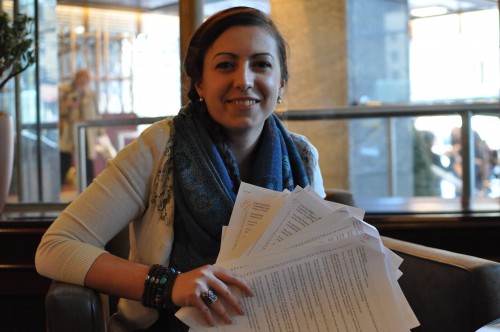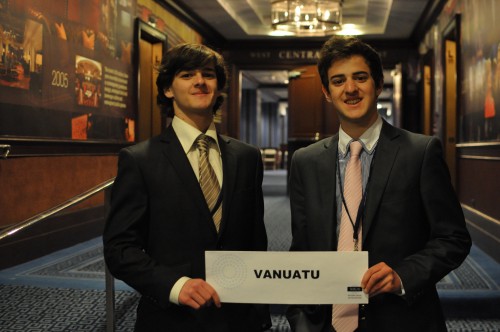The National Model United Nations (NMUN) is the world’s largest conference with over 5,000 delegates. It’s so big that it’s technically split into two conferences with two separate dates and hotel venues since no hotel can hold that many delegates. NMUN was not an official stop on our tour but I decided to drop by to say hi to friends and do some informal interviews since I happened to be in New York for a workshop. Unfortunately, I missed Universidad Central de Venezuela who was the first to ask us for an interview, but I did catch a few other delegates to get their insights about NMUN. For readers who are new to NMUN, read this circuit comparison article first.
I got to speak with three delegates from a variety of MUN experiences who attended NMUN for the first time to get their fresh perspective on the conference and asked questions that allowed them to compare this conference with their previous conference experiences. The interviewees were:
- Miruna B., the head delegate of Vrije Universiteit Brussel in Belgium. Her team attended Oxford OxIMUN, London LIMUN, and Harvard WorldMUN this year.
- Ziad A., the head delegate of Roger Williams University in the United States. His team attends Model Arab League conferences but also attended Yale SCSY this year.
- Olivier D., a delegate from Brunel University in the United Kingdom. He staffed at London LIMUN and attended NMUN Europe in Lille, France.
I had Ziad and Olivier speak on camera and parts of their video interview is below, and Miruna spoke off camera.
1. NMUN’s best qualities are the session at the UN headquarters, diversity, programming, and organization.
Miruna, Ziad, and Olivier were all excited about the last committee session being held at the United Nations headquarters — it’s definitely a treat for any Model UN delegate! NMUN is the only college conference that has a session at the UN headquarters; other Model UN conferences that have access to the facilities are NHSMUN, GCIMUN, NYDRMUN, and Montessori MUN.
Ziad also cited NMUN’s diversity of its delegates coming from all around the world and its strong programming events for the delegates as experiences that are unique to NMUN. Specifically, he mentioned the mission briefings, speakers, and career fair as some highlights of the programming. Miruna thought that NMUN’s biggest strength is that it is well-organized. This reminded me of one of the key differences in the circuit comparison article — foundation-organized conferences tend to have a permanent board with institutional memory whereas college-hosted conferences vary in quality every year depending on their student board turnover.
2. NMUN has a focus on ownership of a draft resolution.
Miruna spoke about how there is a stronger focus on ownership of a draft resolution at NMUN. Compared to her experiences at WorldMUN and on the European circuit, delegates at NMUN were less likely to divide up the clauses when starting to write a draft resolution and were less likely to merge the draft resolutions together. Instead, delegates preferred being a main sponsor to a draft resolution. In her General Assembly-sized committee, this lead to 17 working papers which were eventually converted into 11 draft resolutions, four of which were passed (including hers). There are two side effects to having more draft resolutions. One is that a lot of draft resolutions are very similar, and the ones that were more similar to the others and more general passed voting bloc while the different and specific ones did not. Another side effect of this is that it lead to much longer voting blocs — the interviewees plus several delegates and staff who texted me mentioned that voting took over an hour.
Another key sign of ownership is that all sponsors had to hand in the draft resolution together and the chairs would ask each one if they agreed with the copy that is about to be handed in. My analysis of this is that the disadvantage that it causes is a bottleneck in productivity as the chairs have to work with all the sponsors instead of a designated few primary sponsors of a resolution, but the advantage is that it allows all sponsors to have equal leadership and prevents delegates from backstabbing and other tactics of “losing” parts of a resolution that take place at the most competitive conferences.
3. Work is done during long unmoderated caucuses at NMUN.
Both Miruna and Ziad as well as several other delegates who texted me mentioned that unmoderated caucuses were about 60-90 minutes long. Miruna suggests that one reason this is the case is because draft resolutions are not presented and there is no moderated caucus to speak about it, so delegates need more time to lobby others to vote for their draft resolution during unmoderated caucus. I think it emphasizes a different skill set of interpersonal communication instead of mass communication. My analysis is that because delegates are less likely to divide up clauses, it also takes longer for a delegate to produce a draft resolution on his/her own or with a smaller bloc.
I also think because the committees at NMUN are much larger — they reflect accurate numbers in the UN — committee naturally requires more time spent in unmoderated caucuses to speak with more delegates and to work on resolutions. In fact, all of the largest conferences around the world spend more time on average on unmoderated caucus and less time on the speakers list in order to make participation more widespread in a big committee. Although these college delegates found NMUN unmoderated caucuses to be long, they are in fact not the longest. The THIMUN high school conferences are longer in that they feature a full day of unmoderated caucus called lobbying session. On the opposite end of the spectrum, many college crisis conferences operate in a “permanent” moderated caucus format. None of these formats are superior to one another; conferences have just adapted the rules of procedure and flow of debate to fit what they want to simulate.
4. There is less socializing at NMUN.
We already know from the circuits comparison article that NMUN schedules less social events compared to many other college conferences and fills in free time with academic programming instead. In addition, the conduct in committee is more strict at NMUN and socializing is not allowed during unmoderated caucus. This is a huge positive for conferences that hope to instill professionalism in its delegates. I also think it’s a characteristic shared by foundation-hosted conferences — the conferences hosted by THIMUN, UNA-USA, and IMUNA are all more strict on rules of procedure and professionalism than the average college-hosted conference. The downside is that some mature college students who view light socializing as a positive and even an essential part of the committee experience may feel that their networking opportunities are more restricted.
There are other reasons why the conference is less social. Miruna compares her experiences at Oxford OxIMUN and London LIMUN and notes that delegates at those conferences have seen each other before and know people from different teams when they first walk in — they are part of a circuit. At NMUN, she didn’t know many people at the start — this is partially due to the fact that she’s new to the conference, but I also think it’s because most of the schools that attend NMUN participate at regional conferences throughout the year (e.g. AMUN, SRMUN) and don’t see other teams from across the country until they get to NMUN. Olivier also mentioned that a smaller conference like NMUN Europe structurally allowed for more personal interaction and socializing whereas a big conference like NMUN required a different type of interaction that focused more on getting work done. Nevertheless, not socializing does not mean delegates don’t meet each other at NMUN and make new friends — it just means many more introductions are required at the beginning of committee.
5. The quality of debate is high at NMUN.
There sometimes seems to be this rivalry between schools that attend organization-hosted conferences such as NMUN and schools that attend college-hosted conferences such as Harvard HNMUN or U.Penn UPMUNC (called the “World Division” on this website) on which side of the circuit does Model UN better. I wish I could have asked the question to top-notch crossover teams like Florida International or Universidad Central de Venezuela, but I asked Miruna anyway since she had attended WorldMUN and she had some good insights.
Her key takeaway is that the quality of debate is high at NMUN and that the delegates are prepared to participate in committee at a high level. In terms of comparing NMUN with other conferences, she thinks the difference in the feel for the conferences can be attributed to three factors. First, the rules, flow of debate, and even the awards structure are very different and require different skill sets and leadership styles. Model UN is simply done differently and delegates who are not used to the way things are done at a certain conference will feel that it is foreign. Second, she noticed that teams that went to both WorldMUN and NMUN send different delegates to the different conferences — we can’t assume just by looking at the school name that their set of delegates are the same, and it’s important to note that delegates from the same school thrive at different conferences. Finally, she felt that delegates at WorldMUN conferences were more “professional” in the sense of experience (not conduct) — they simply do Model UN more often and have this veteran rhythm and confidence, although that does not necessarily mean they are better in committee. My additional thought having read the circuits comparison article is that delegates on the World Division circuit take actions inside and outside committee to make it feel more competitive, but that the substantive content is equally good on both circuits.
Ultimately, the overarching theme of all the comparison articles on our website is that every conference is different in conduct and its values and schools need to choose conferences that fit what they want to experience. For over 5,000 college students, they chose NMUN as the pinnacle of their Model UN experience. Learn more by visiting http://nmun.org/.

Miruna from Vrije Universiteit Brussel holds up the 11 resolutions that were produced in her committee at NMUN. Four of them, including one of hers, passed.

Ziad and the rest of the Roger Williams University team received a mission briefing at the Swedish Mission to the United Nations. NMUN puts a strong emphasis on academic programming for its delegates.
What are your thoughts on NMUN?


